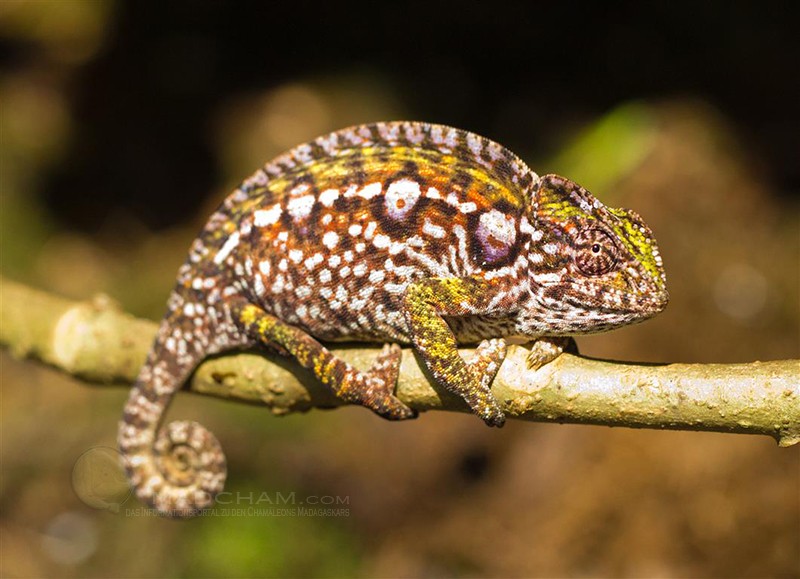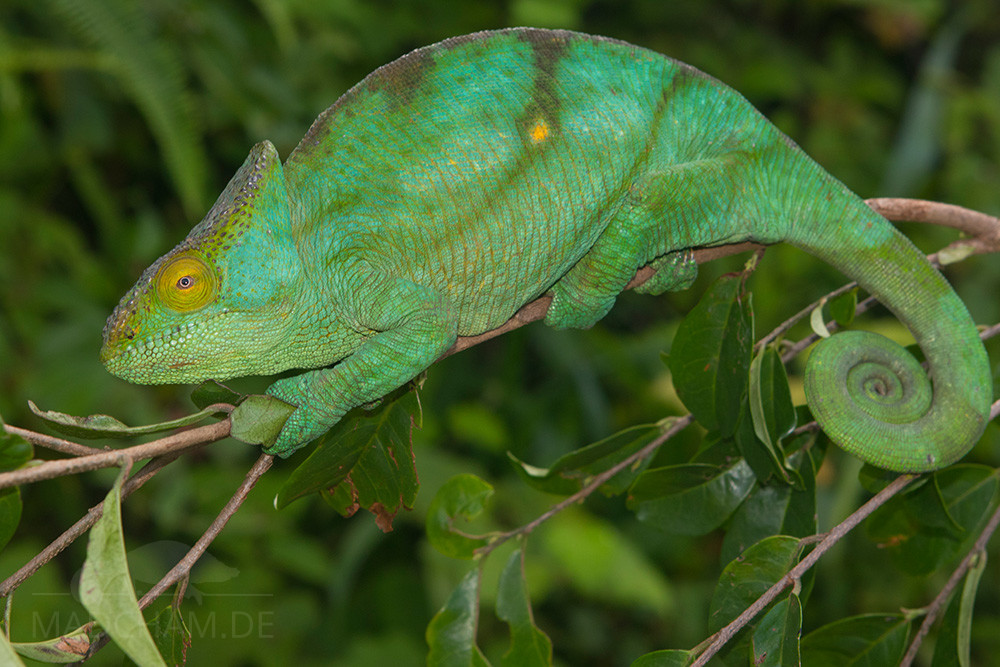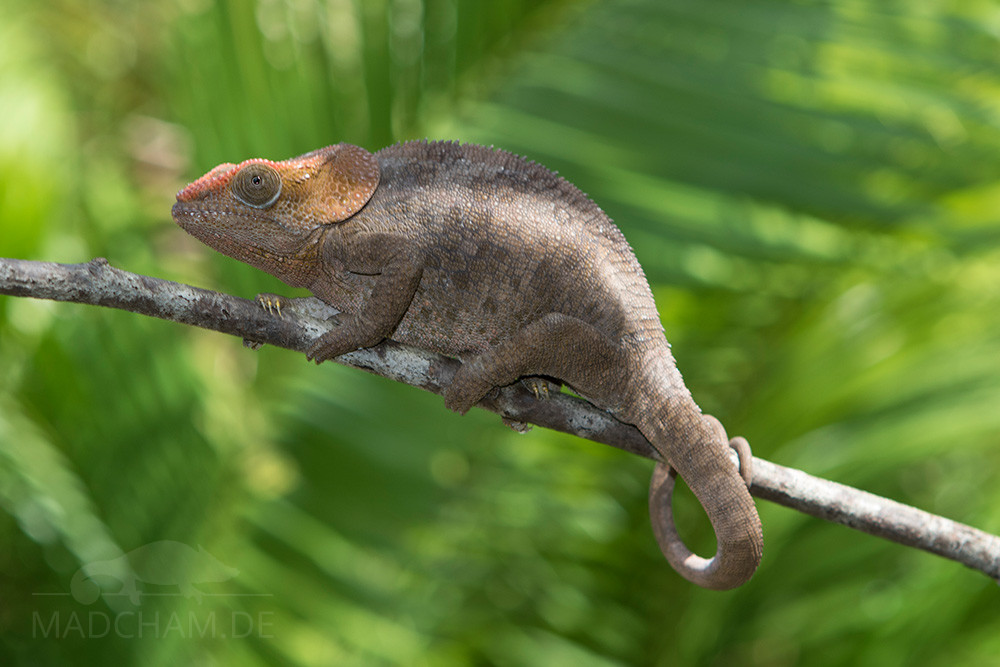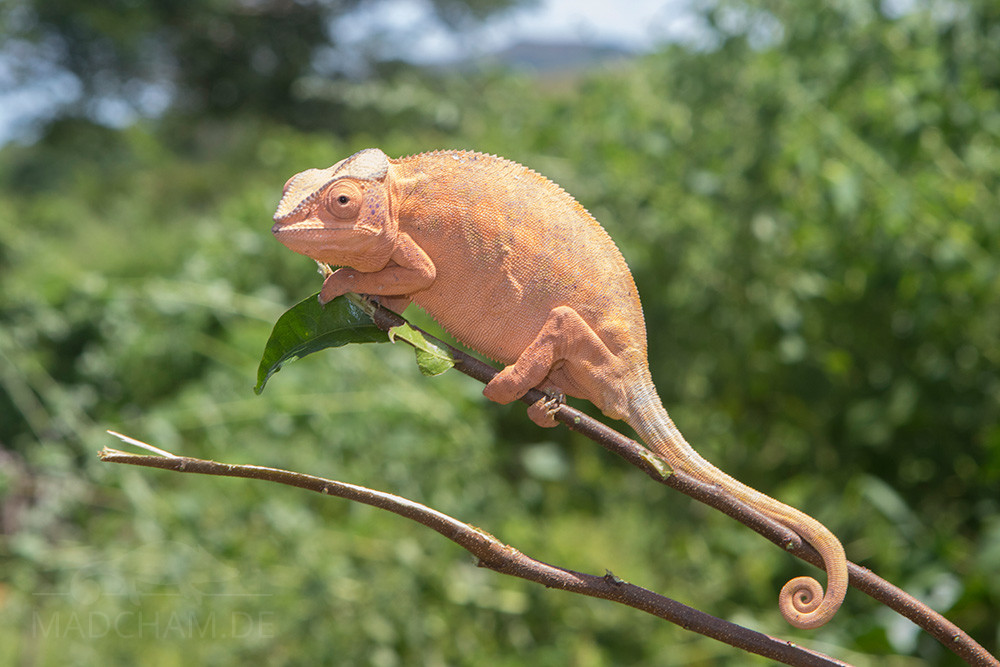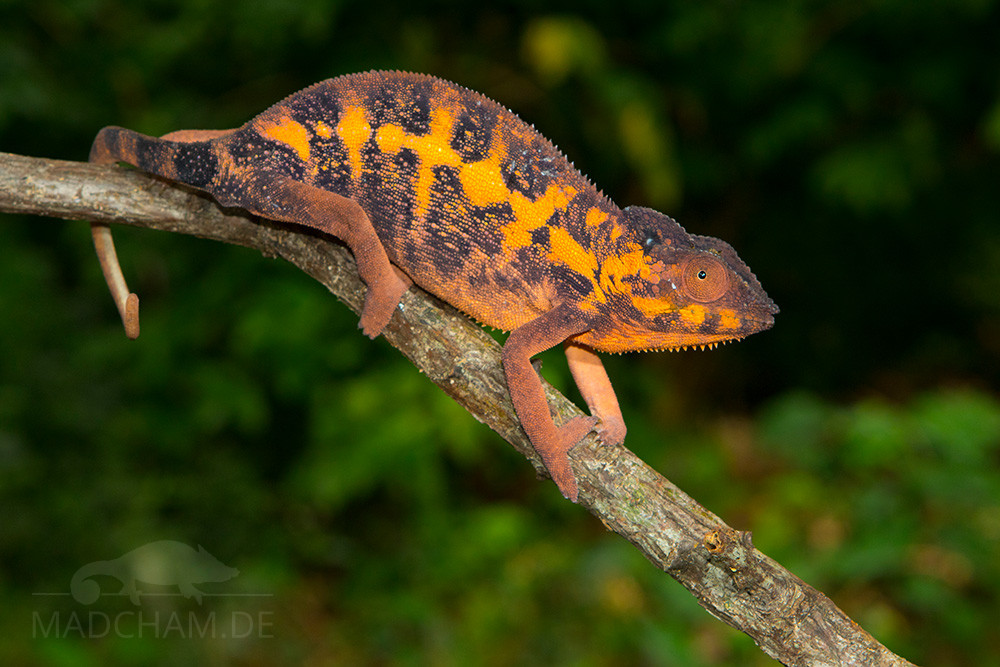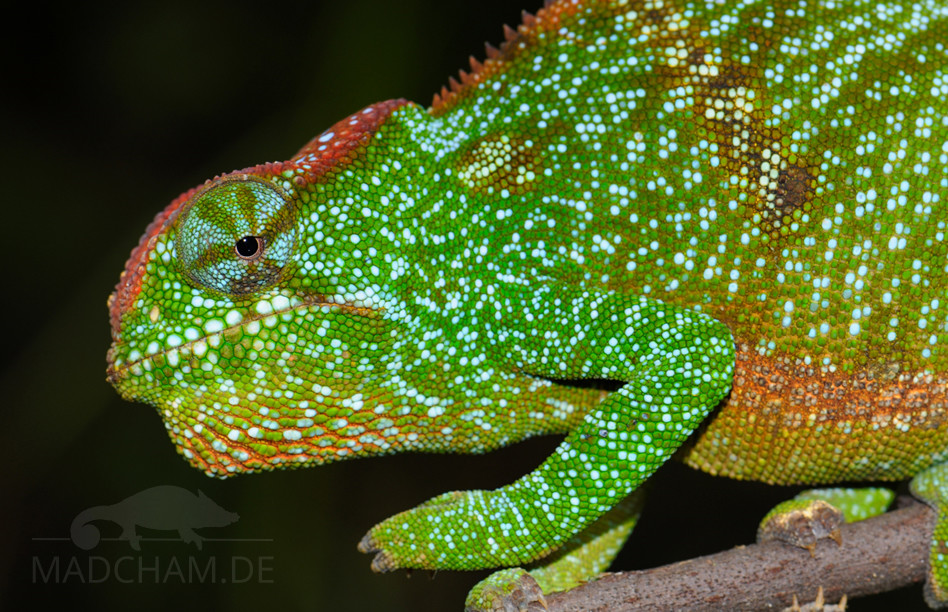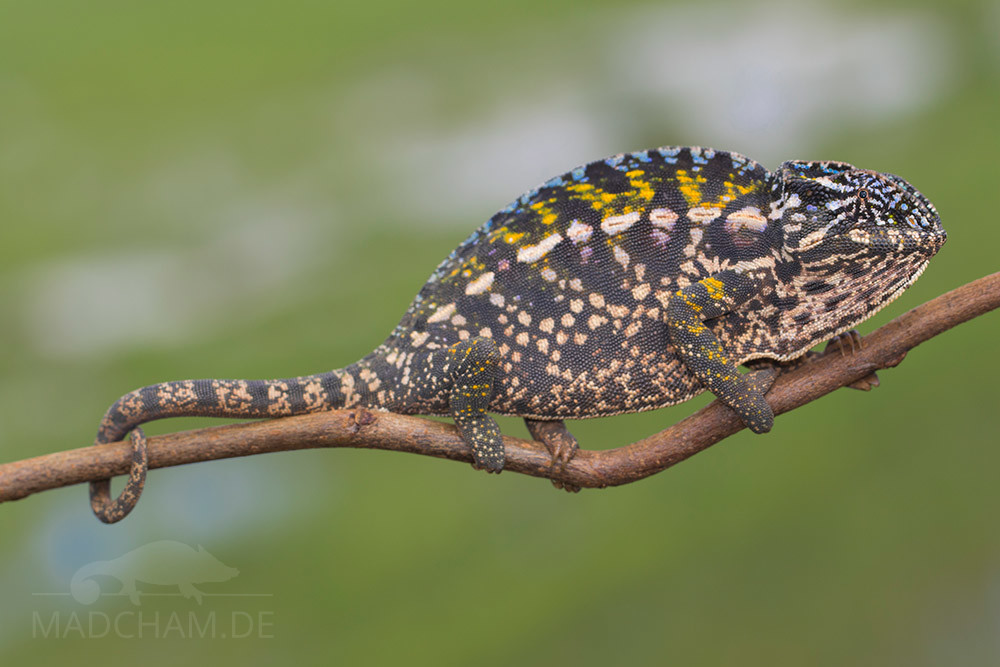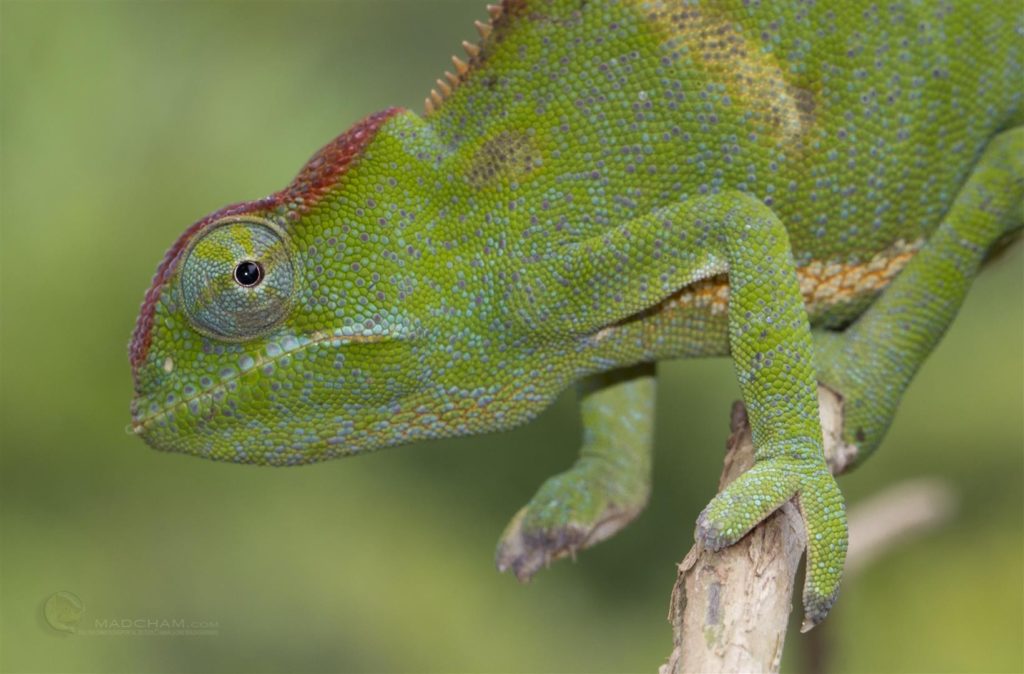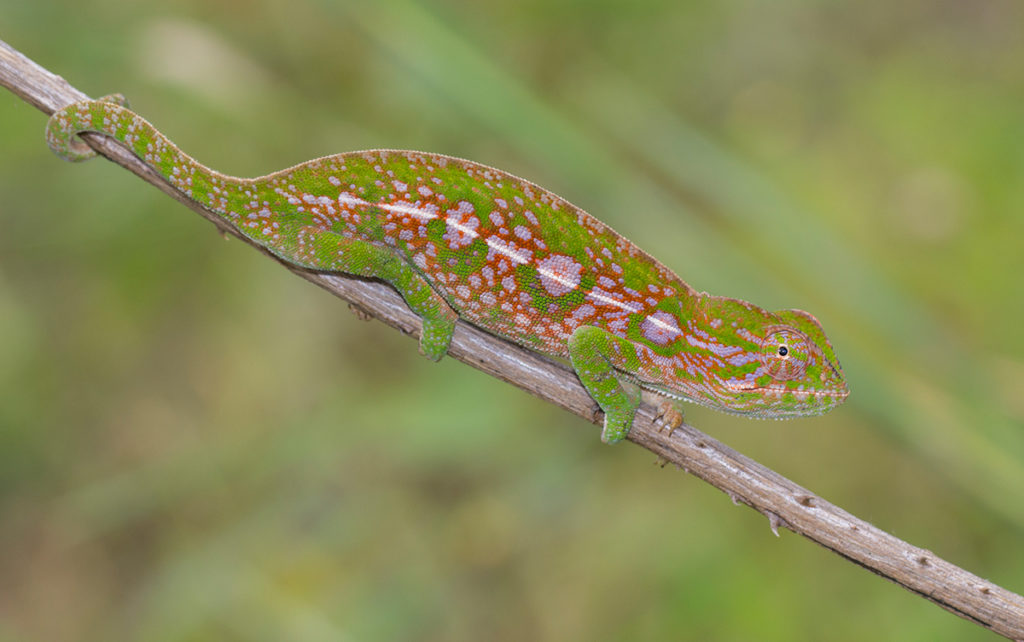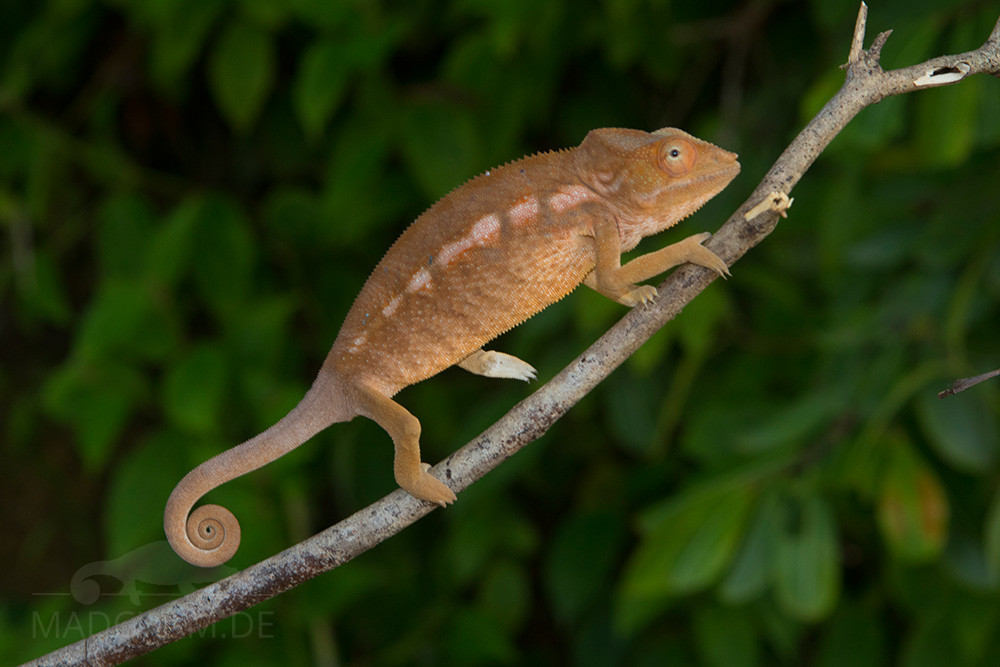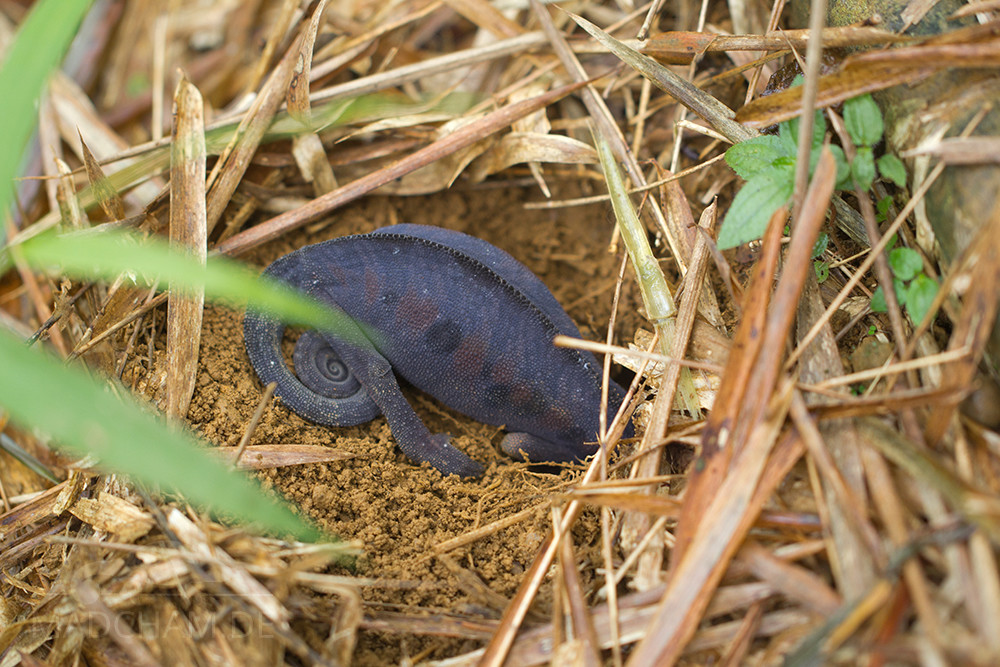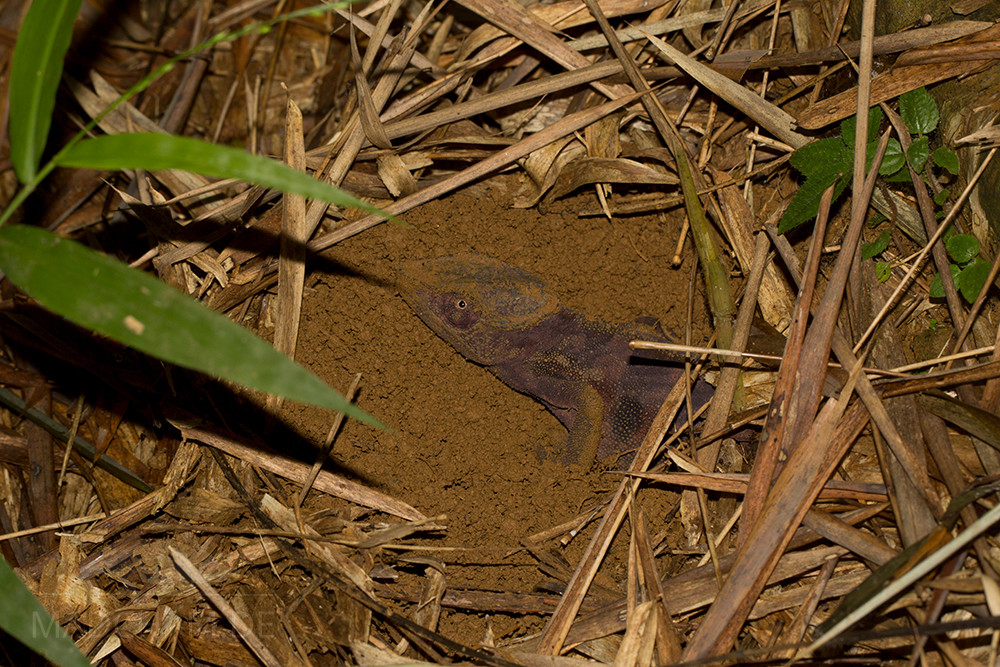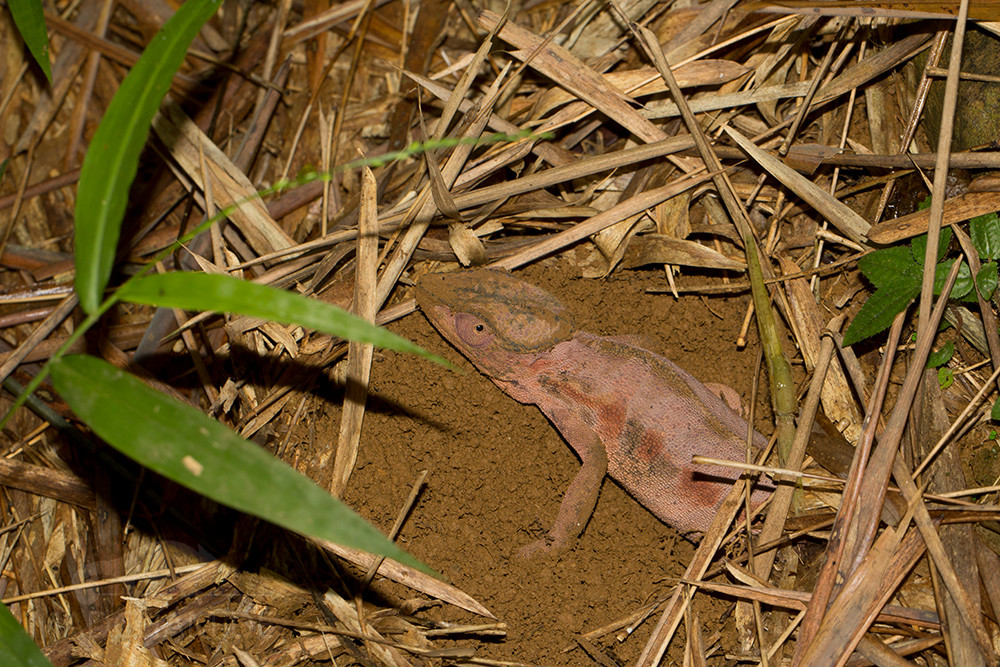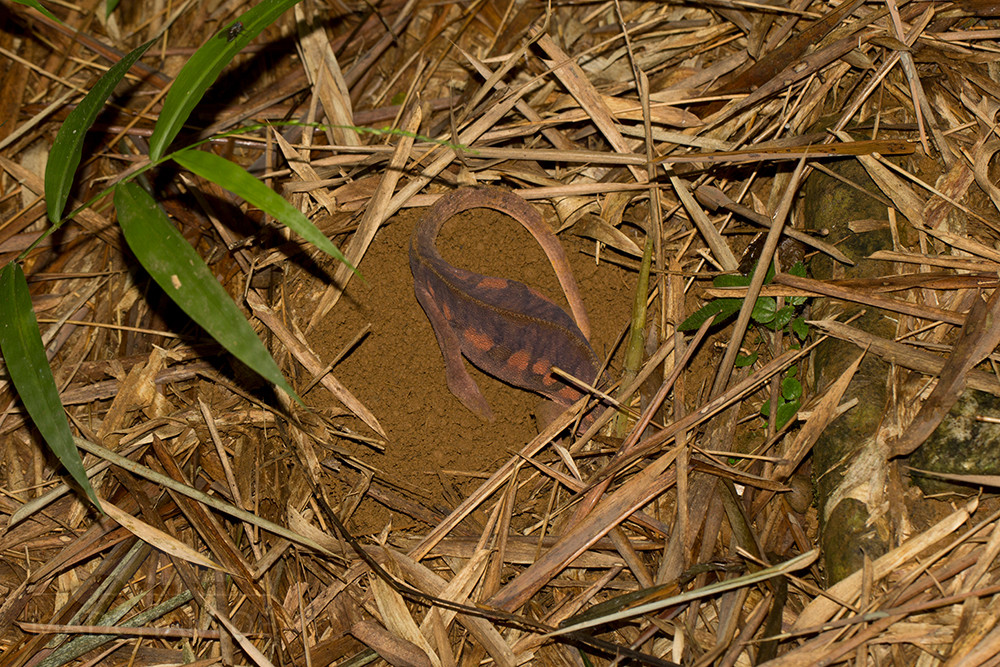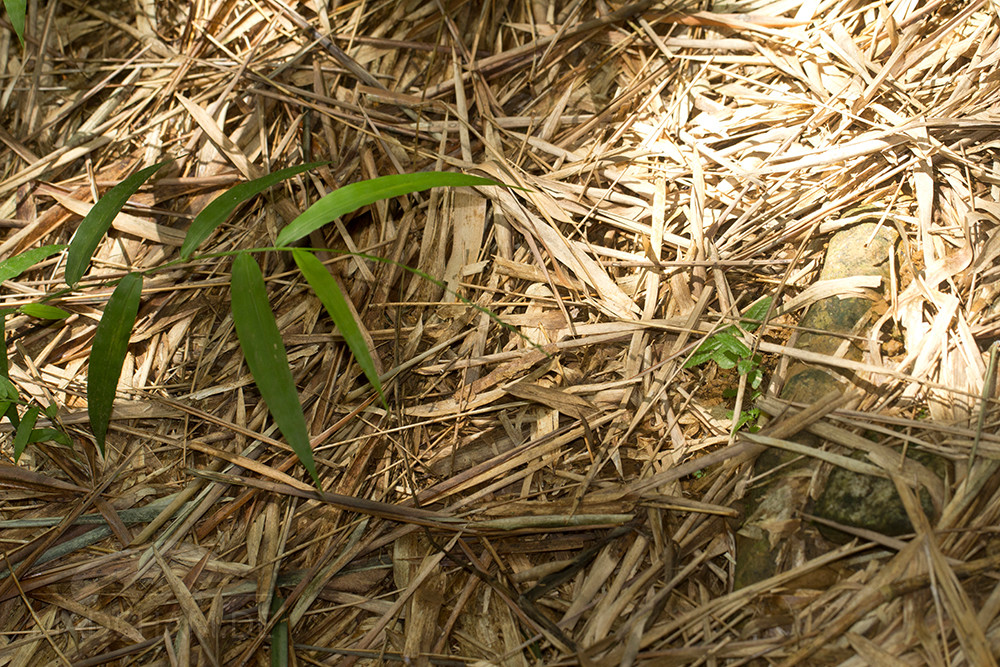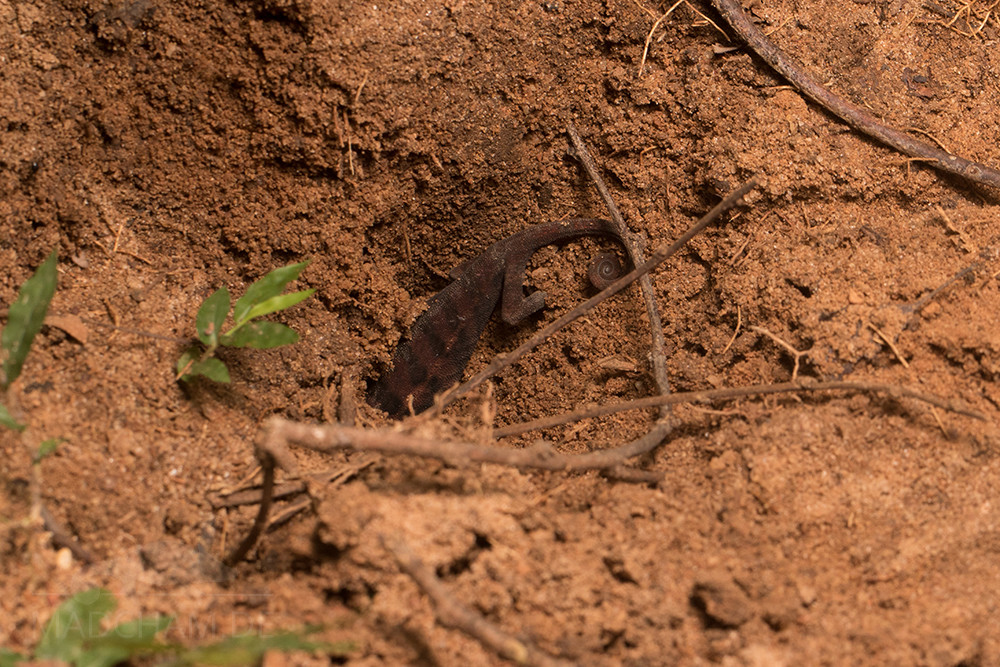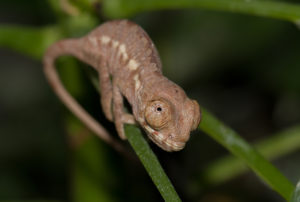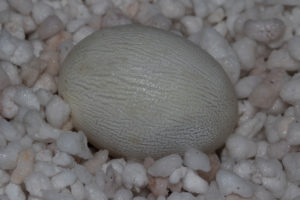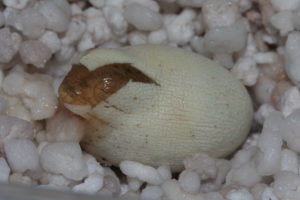Gravidity
A successful mating between female and male of a chameleon species is followed by gravidity. Right after mating, the female usually does not want to be with the male anymore. In Madagascar, mating and gravidity fall within the rainy season, so depending on the season somewhen between October and April. In captivity outside Madagascar, it is possible that mating and gravidity take place outside these months, too. The length of gravidity varies between the different chameleon species. You can find data about the length under our species descriptions in “chameleons and habitat data”. In many chameleon species, females soon show a certain gravidity coloration which is very different from their normal coloration. See some examples below.
Already before mating, follicles have been growing on the female’s ovaries. At the time of ovulation, the follicles rupture and let the egg cells escape. The fallopian tube receives the egg cells. Fertilization of the female egg cells with male sperms takes place shortly after mating right inside the fallopian tube. The epithelium of both tubes builds the egg membranes. After a few days, lime begins to deposit on the egg membranes. This process continues until the egg membrane is completely covered by a thin lime shell. In chameleons, eggs are soft-shelled and not as hard as in birds or tortoises.
Concerning feeding, females may get a little more food during the last third of gravidity. Before gravidity, females should not be fed too much since this may lead to huge clutches that weaken the female enormously. During the whole gravidity, you have to take special care for supplementation. The vitamin content of the eggs directly depends on the vitamin supply of the mother. Additionally, the female needs more calcium during gravidity to build the eggshells. Studies prove that an ideal supply of the mother with UV-B radiation improves the hatching success of a clutch.
Gestation period
Females of different chameleon species are gravid for different lengths of time. The following table provides an overview of gravidity lengths.
| Species | Gestation period |
Source |
| Brookesia stumpffi | 40 days | |
| Brookesia superciliaris | 45 days | |
| Brookesia thieli |
31 days | |
| 30-60 days (up to 90 days) | Nash (2022): Keeping and breeding Brookesia thieli. |
|
| Calumma globifer | 90-120 days | |
| Calumma linotum |
22-40 days | Nash (2023): Keeping and breeding Calumma linotum. |
| Calumma parsonii parsonii | 152-243 days | own experience |
| Calumma roaloko |
22-40 days | Nash (2023): Keeping and breeding Calumma roaloko. |
| Furcifer balteatus | 90-120 days | |
| Furcifer lateralis |
40-45 days | own experience |
| 30-50 days | Schmidt & Tamm (1987): Nachzucht vom Teppich-Chamäleon, Chamaeleo (Furcifer) lateralis, im Terrarium. Die Aquarien- und Terrarien-Zeitchrift DATZ 40 (12): 561-563. | |
| 30-52 days | ||
| 30 days | ||
| 30-40 days | ||
| Furcifer minor | 64 days | |
| Furcifer oustaleti | 31-45 days | Smith & Abate (1999): Chameleon Profile, Oustalet’s Chameleon. Chameleon information network 32: 19-25. |
| Furcifer pardalis | 30-40 days | own experience |
| 31-45 days | Schmidt & Tamm (1988): Furcifer pardalis (Cuvier). Sauria 10 (1): 101-104. | |
| 28-45 days | Schmidt & Henkel (1989): Pantherchamäleons. Chamaeleo (Furcifer) pardalis im Terrarium. Die Aquarien- und Terrarien-Zeitschrift DATZ 42(5): 280-282. | |
| 28 days | ||
| 19 days | ||
| Furcifer verrucosus | 28-42 days | Abate & Kalisch (1995): Chameleon Profile, Warty Chameleon. Chameleon information network 15: 17-24. |
| 56-70 days | ||
| 50-60 days |
Test tunnels and egg-laying
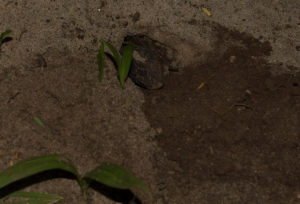
A Furcifer pardalis female lays her eggs in the sand, near Diego Suarez
It needs some preparation before a chameleon female can lay her eggs without problems. The female should be inside a terrarium with deep soil of 20 to 30 cm in height. A mixture of sand and forest soil has proven to work especially well for burrowing. During the last days of gravidity, the soil should always be kept humid, because it is easier to dig in the humid ground. Most females stop eating shortly before egg-laying. Plants rooting directly in the soil are very attractive for chameleon females. Heat mats under the soil are rather counterproductive – the soil becoming warmer in the depth may disturb the female while burrowing or in the worst case, prevent her from laying eggs at all.
Better place a privacy screen in front of the cage when the female begins roaming around the bottom of the terrarium – she is looking for a suitable place for her eggs. The less you disturb the female, the fewer problems she has in laying eggs. Especially young and inexperienced females dig test tunnels some days for the actual tunnel for the eggs. They dig burrows but do not lay eggs yet. This behavior is normal and disappears with increasing age and increasing numbers of gravidities. Has the female finally found the right place – they love to dig between roots – she digs a deep hole. If deep enough, she turns around, and usually, only the heads look out the burrow while she lays her eggs one by one. After egg deposition, the female turns around again to put the soil back in place carefully. She even puts leaves on top of the burrow so you cannot recognize where she dug afterward. This behavior is part of the egg-laying process, so do not disturb the female until she has finished her works completely and climbs back up on branches. If you have carefully peeked into the terrarium before, you however already know where she laid her eggs.
From some species such as Furcifer lateralis it is known that some females let eggs drop from branches instead of digging a hole. We have never watched such behavior in Madagascar yet. Leaf chameleons (Brookesia ssp.) usually lay only one or two eggs and they do not bury them, but hide them under pieces of wood and foliage. Every egg laying is very exhausting for a chameleon female. So please grant your female peace and silence after successful egg deposition. Offer supplemented feeders and a working dripper. The chameleon female does not care for her offspring after egg laying.
If a female stops digging completely but has not laid eggs or if the female becomes unusually calm or even closes her eyes during the day, you will need to see a vet as soon as possible. Your female may be egg-bound which will end deadly if left untreated. Please do not hesitate and act quickly.
It is good to know that females may build eggs even without mating. These eggs are infertile. Many Malagasy chameleons are able to “store” semen after one single mating and thus are able to build more fertile clutches without more mating. In these cases, the number of fertile eggs decreases with an increasing number of clutches. Please dig out clutches quickly after egg deposition to move them into incubators. You can find more information about the incubation of chameleon eggs in this article.
Clutch size
In terraristics, clutch sizes are usually somewhat larger than in nature because the females can be very well cared for during pregnancy. In nature, they depend on the rainy season, which is more intense or shorter depending on the year. Accordingly, the food supply on Madagascar can change – and with it the possibility of the female to mate and produce eggs. The following table gives an overview of the clutch sizes of Madagascan chameleon species known so far.
| Brookesia desperata | 2 eggs | |
| Brookesia exarmata | 2 eggs | |
| Brookesia minima | 2 eggs | Schmidt (1988): Brookesia minima Boettger. Sauria 10(4): 33-36 |
| Brookesia stumpffi | 3-5 eggs | |
| 2 eggs | ||
| Brookesia superciliaris | 4 eggs | |
| Brookesia thieli | 3-4 eggs | |
| 3-5 eggs | Nash (2022): Keeping and breeding Brookesia thieli. |
|
| Brookesia tristis | 2 eggs | |
| Calumma globifer | 15-30 eggs | |
| Calumma linotum |
2-3 eggs | Nash (2023): Keeping and breeding Calumma linotum. |
| Calumma parsonii parsonii |
24-45 eggs | own experience |
| 35 eggs | Kalisch (1994): Chameleon profile Parson’s chameleon. Chameleon information network 12: 10- 18. | |
| 20-31 eggs | Tröger (1997): Remarks about the long-term captive care and first steps towards captive breeding of Calumma parsonii. Chameleon information network 25: 29-36. | |
| 69 eggs | ||
| Calumma roaloko |
2 eggs | Nash (2023): Keeping and breeding Calumma roaloko. |
| Furcifer labordi | 8 eggs | |
| Furcifer lateralis |
10-15 eggs | own experience |
| 4-23 eggs | ||
| 6-11 eggs | Schmidt (1985): Chamaeleo lateralis Gray. Sauria 7(4): 25-26. | |
| 6-33 eggs | Schmidt & Tamm (1987): Nachzucht vom Teppich-Chamäleon, Chamaeleo (Furcifer) lateralis, im Terrarium. Die Aquarien- und Terrarien-Zeitchrift DATZ 40 (12): 561-563. | |
| Furcifer major | 10-16 eggs | |
| 8-23 eggs | ||
| Furcifer minor | 14 eggs | own experience |
| 9 eggs | ||
| Furcifer oustaleti | up to 61 eggs | Smith & Abate (1999): Chameleon Profile, Oustalet’s Chameleon. Chameleon information network 32: 19-25. |
| 17-72 eggs | ||
| Furcifer pardalis |
15-35 eggs | own experience |
| 12-50 eggs | Ferguson, Murphy, Raselimanana, Ramanamanjato, Annis (1994): Chameleon Profile, The Panther Chameleon. Chameleon information network 11: 11-20. | |
| 16 eggs | ||
| 16-44 eggs | Schmidt & Tamm (1988): Furcifer pardalis (Cuvier). Sauria 10 (1): 101-104. | |
| 22 eggs | ||
| 16-29 eggs | ||
| 24 eggs | ||
| Furcifer timoni | 10-14 eggs | |
| Furcifer verrucosus | up to 30 eggs | |
| 18-26 eggs | ||
| Furcifer voeltzkowi | 7 eggs |

